Introduction:
Child labor remains a distressing global issue, robbing millions of children of their childhood and hindering their overall well-being. In this blog, we will delve into the profound consequences of child labor on children's health, education, and development, shedding light on the urgent need for its eradication.
Understanding Child Labor: Definition, Forms, and Prevalence
- Define child labor and highlight its various forms, including hazardous work, forced labor, and trafficking.
- Present alarming statistics and the global prevalence of child labor, emphasizing its detrimental effects on children worldwide.
Impact on Physical and Mental Health:

- Examine the physical health implications of child labor, such as exposure to dangerous conditions, hazardous substances, and long working hours.
- Discuss the psychological toll of child labor, including increased stress, anxiety, and the loss of self-esteem.
Stifling Education and Hindering Future Opportunities:
- Explore how child labor disrupts access to education, limiting children's opportunities for personal growth and advancement.
- Highlight the barriers faced by child laborers, such as lack of quality education, limited resources, and long working hours hindering their ability to attend school.
Impeding Social and Emotional Development:
- Discuss the adverse impact of child labor on children's social interactions and emotional well-being.
- Explore how the absence of a nurturing environment, limited interactions with peers, and exposure to exploitation can hinder the development of essential social skills.
Breaking the Cycle: Advocacy and Policy Solutions:
- Highlight global efforts and organizations dedicated to confronting child labor and promoting children's rights.
- Discuss effective policy interventions and legislation aimed at eradicating child labor, such as enforcing labor laws, improving access to education, and providing social support systems to vulnerable communities.
Addressing the Root Causes:
- Identify the underlying factors that perpetuate child labor, such as poverty, lack of social protection, inadequate access to quality education, and supply chain issues.
- Present strategies to tackle these root causes, including poverty alleviation programs, awareness campaigns, corporate responsibility initiatives, and implementation of fair trade practices.
Impact on Sustainable Development Goals:
- Discuss how eliminating child labor contributes to achieving the United Nations' Sustainable Development Goals, particularly Goal 4 (Quality Education) and Goal 8 (Decent Work and Economic Growth).
- Emphasize the interconnectedness of various societal issues and the importance of a holistic approach to address child labor.
Empowering Children and Communities:
- Highlight successful initiatives promoting child rights, such as vocational training programs, awareness campaigns, and community empowerment projects.
- Encourage readers to support organizations working towards the eradication of child labor and advocate for stronger laws and policies.

Conclusion:
Child labor remains a significant impediment to the well-being, education, and development of millions of children worldwide. By understanding the immense physical, mental, and social consequences inflicted upon child laborers, we can collectively work toward a future free from exploitation. Through advocacy, rigorous policy interventions, and unwavering commitment, we can create a world where children can thrive, enjoy their right to education, and build a brighter future for themselves and generations to come.




